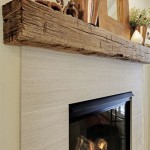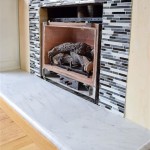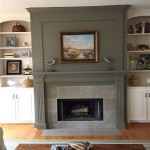Elevating Fireplace Aesthetics: Integrating Wood Walls Above the Mantel
The fireplace, traditionally a focal point of a home, often serves as a gathering place and a source of warmth, both literally and figuratively. Increasingly, homeowners and designers are seeking ways to enhance the aesthetic appeal of the fireplace area. A prominent trend in interior design involves extending the fireplace's visual presence upwards by incorporating a wood wall above the mantel. This design element can transform a simple fireplace into a striking architectural feature, adding texture, warmth, and visual interest to the entire room.
The application of wood above a fireplace is not merely a cosmetic addition. It represents a deliberate design choice that can influence the room's overall atmosphere, style, and perceived value. This article explores the various aspects of integrating wood walls above fireplaces, covering design considerations, material choices, potential challenges, and installation guidelines.
Design Considerations for Wood Walls Above Fireplaces
Planning a wood wall above a fireplace requires careful consideration of several factors to ensure a cohesive and visually pleasing outcome. These considerations extend beyond simply selecting a wood type; they encompass the overall design intention, the existing architectural style of the home, and the functional aspects of the fireplace itself.
Firstly, the scale and proportion of the wood wall must be carefully assessed. The height and width of the wood feature should be proportionate to the size of the fireplace and the surrounding wall space. A wood wall that is too small may appear insignificant, while one that is too large can overwhelm the room. The verticality of the wood wall can also influence the perceived height of the room, making it appear taller if designed appropriately. The existing mantel's dimensions also play a key role; the wood feature should complement, not detract from, the mantel's presence.
Secondly, the style of the wood wall should align with the overall aesthetic of the home. For a modern home, sleek, minimalist designs using light-colored woods or geometric patterns might be suitable. In contrast, a rustic or traditional home might benefit from reclaimed wood, textured finishes, or more intricate paneling. The chosen style should contribute to and enhance the existing design elements of the room, creating a harmonious and unified space. A farmhouse-style home would likely benefit from shiplap or board-and-batten detailing, whereas a more contemporary design might incorporate wider planks with a smooth, even finish.
Thirdly, the color and finish of the wood should be carefully selected to complement the existing color palette of the room. Warm wood tones can create a cozy and inviting atmosphere, while cooler tones can lend a more sophisticated and contemporary feel. The finish, whether it be a natural oil, a stain, or a paint, should be chosen based on the desired level of sheen and durability. Consider how the wood's color will interact with the fireplace surround, the wall paint, and any existing furniture. Contrast can be effective, but it must be carefully managed to avoid a jarring or clashing effect. For example, a dark stone fireplace surround might be beautifully contrasted with a lighter, natural wood wall.
Finally, consider the integration of other design elements, such as lighting and decorative objects. Recessed lighting can highlight the texture and pattern of the wood, while sconces can add a touch of elegance and create a warm ambiance. Decorative objects, such as artwork, mirrors, or shelves, can be incorporated into the wood wall to add visual interest and personalization. However, it is important to avoid overcrowding the space and to maintain a sense of balance and harmony. The selection of accessories should complement the wood wall and enhance its overall impact.
Material Options for Wood Walls Above Fireplaces
The choice of wood is a critical decision that impacts both the aesthetic appeal and the long-term performance of the wood wall. A wide range of wood species and materials are available, each with its unique characteristics, advantages, and disadvantages. The selection should be based on factors such as appearance, durability, cost, and environmental impact.
Solid wood remains a popular choice, offering a natural beauty and inherent durability. Hardwoods, such as oak, maple, and walnut, are known for their strength and resistance to wear and tear, making them suitable for high-traffic areas. Softwoods, such as pine and cedar, are more affordable and easier to work with, but they are also more susceptible to scratches and dents. The grain pattern, color, and texture of solid wood can vary significantly depending on the species, offering a wide range of aesthetic options. Consider the natural characteristics of the wood and how they will contribute to the overall design.
Reclaimed wood is another excellent option, offering a unique, rustic aesthetic and a sustainable choice. Reclaimed wood can come from a variety of sources, such as old barns, factories, and warehouses. It often has a weathered appearance and contains unique imperfections, such as nail holes and saw marks, which add character and charm. Reclaimed wood is typically more expensive than new wood, but its unique aesthetic and sustainable qualities make it a worthwhile investment for some homeowners. It's crucial, however, to ensure the reclaimed wood is properly treated and free from pests or contaminants before installation.
Engineered wood products, such as plywood, MDF (medium-density fiberboard), and veneer, offer a more affordable and consistent alternative to solid wood. Plywood is made from layers of wood veneer glued together, providing strength and stability. MDF is made from wood fibers compressed together, offering a smooth, uniform surface that is ideal for painting or laminating. Veneer consists of a thin layer of real wood applied to a substrate, providing the appearance of solid wood at a lower cost. Engineered wood products are less susceptible to warping and cracking than solid wood, making them a good choice for areas with fluctuating humidity levels. However, they may not have the same natural beauty and character as solid wood.
Beyond standard wood options, consider specialized wood products like shiplap, board-and-batten siding, or even decorative wood panels. Shiplap provides a classic, clean look with its interlocking boards, while board-and-batten offers a more rustic and textured appearance. Decorative wood panels can add intricate patterns and visual interest to the wood wall. The choice of material should be carefully considered to achieve the desired aesthetic and performance characteristics.
Installation Guidelines and Safety Considerations
Installing a wood wall above a fireplace requires careful planning, proper preparation, and adherence to safety guidelines. Incorrect installation can result in structural issues, fire hazards, and aesthetic imperfections. While professional installation is recommended for complex projects, homeowners with experience in carpentry can often tackle simpler installations themselves.
Prior to installation, it is essential to ensure that the fireplace meets all local building codes and fire safety regulations. The wood wall should be installed at a safe distance from the fireplace opening to prevent the risk of fire. Consult with a qualified professional to determine the appropriate clearance distances based on the type of fireplace and the materials being used. Heat shields might be necessary to protect the wood from excessive heat exposure.
The wall surface should be thoroughly prepared by cleaning it and ensuring that it is level and free from any imperfections. Any existing paint or wallpaper should be removed, and any holes or cracks should be filled. A vapor barrier may be necessary to prevent moisture from damaging the wood wall. Accurately measure the area to be covered and plan the layout of the wood planks or panels to minimize waste and ensure a symmetrical appearance.
The installation process will vary depending on the type of wood and the desired aesthetic. Solid wood planks can be installed using nails, screws, or adhesive. Engineered wood products can also be installed using similar methods. It is important to use the appropriate fasteners and adhesives for the specific materials being used. Ensure that the planks or panels are properly aligned and spaced to create a uniform and visually appealing surface. Use a level to ensure that the wood wall is plumb and straight.
Safety is paramount during the installation process. Wear appropriate personal protective equipment, such as safety glasses, gloves, and a dust mask. Use power tools safely and follow the manufacturer's instructions. Be aware of electrical wiring and plumbing behind the wall, and take precautions to avoid damaging them. If the installation involves working at heights, use a sturdy ladder or scaffold and ensure that it is properly secured. If unsure about any aspect of the installation process, consult with a qualified professional.
Finally, proper finishing and maintenance are essential to ensuring the longevity and beauty of the wood wall. Apply a sealant or finish to protect the wood from moisture and wear and tear. Regularly clean the wood wall with a soft cloth and a mild detergent. Avoid using harsh chemicals or abrasive cleaners, as they can damage the finish. Inspect the wood wall periodically for any signs of damage, such as cracks, warping, or insect infestation, and address any issues promptly.

Cheyenne S Fireplace Transformation Plank And Mill

Barn Wood Accent Wall For The Fireplace Oh My Gosh I Am Absolutely In Love With This So Want House Wis Home

How To Install Shiplap Above A Fireplace Fox Hollow Cottage

Wood Plank Wall Above Fireplace Family Room Decor

How To Add Wood Trim Above Fireplace Mantle

Diy Fireplace Makeover Wood Slat

How To Install Shiplap Above A Fireplace Fox Hollow Cottage

30 Art Above Fireplace Ideas For An Eye Catching Focal Point Home Living Room Shiplap

Reclaimed Wood Above Fireplace Wall Makeover Remodel

Can You Put Shiplap Around A Fireplace
Related Posts








